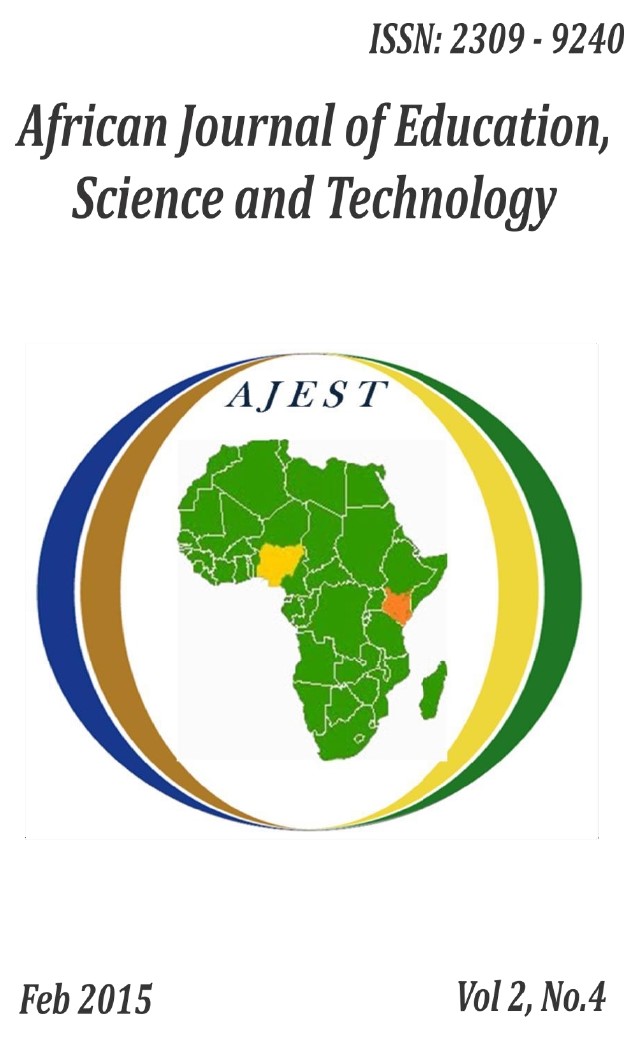Morphological Errors Made by Secondary School Learners and their Effect on Writing in Kenya
##article.abstract##
This paper examines the morphological errors made by students in secondary schools and how these errors affect the quality of learners‘writing. Theseare the underlying issues that emerged out of a research conducted in Migwani Sub-county of Kitui County, 2012-2013. The study was based on Ellis (1994) Error Analysis Model, which outlines four major steps in error analysis namely: selection of corpus identifying errors, classifying errors and explanation of the different types of errors. The study focused in form one learner‘s in secondary schools. It employed purposive, stratified and random sampling techniques. Teacher questionnaire and learners‘ essays were used to collect data. The data collected was analyzed qualitatively and quantitatively through the use of numbers, descriptive statistics and presented in frequency tables and percentages.The study revealed that morphological errors affect learners‘ quality writing; most learners used the present tense where the past tense should have been used, they also attached the past tense marker to an infinite, they also had affixation and prefixation errors and finally wrong plural formation errors. The study recommends: Teachers should pay more attention to writing to help learners to develop skills in producing standard language. This can be done by giving more frequent writing assignments at least once a month. Teachers of English need also to carefully go through the KIE English syllabus and the KNEC essay marking scheme. This will make them realise how seriously morphological errors are taken and allow them to guide their learners from an informed position.
References
Akande, A. (2001). Learners‘ competence versus morphological appropriateness in the acquisition of English.
Ife Studies in English Language: 36-45.
Allen, B.P., & Corder, S.P. (Eds.). (1974). Techniques in Applied Linguistics: The Edinburgh Course in Applied Linguistics. London: Oxford University Press.
Anderson, G., & Stephen, R. (2008). The English Group Genitive is a Special Critic‘English Linguistics 25, pp.
1–20.
Aronoff, M., & Rees-Miller, J. (2007).The handbook of linguistics. Oxford: Blackwell.
Carson, J. (Eds.) (2001). Second language writing and second language acquisition. Mahwah, NJ: Lawrence Erlbaum associates.
Corder, S.P. (1967).The significance of learners' errors. New York: Oxford University Press
Corder, S. P. (1974). Error Analysis.London: Oxford University Press.
Ellis, R. (1994). The study of second language acquisition. Oxford: Oxford University Press. Ellis, R. (1996). SLA Research and Language Teaching. Oxford: Oxford University Press.
Friedlander, A. (1990). Composing in English: Effects of a first language on writing in
Fraenkel, D., &Wallen, N. (2000).Sampling: A handbook on educational research. Nairobi: New Kemit Publishers.
Gabrys- Barker, D. (2008). Morphosyntactic issues in second language acquisition: Multilingual matters Vol.
29.
Greenbaum, S. (1996). Oxford English Grammar.Oxford University Press.
Hawkins, R. (2001). Second language syntax: A generative introduction. Oxford:Blackwell Publishers Limited. Hedge, T. (1999). Writing. (11thed.). Oxford: O.U.P.
Hsieh, C., Tsai, T., Wible, D., & Hsu, W. (2002) Exploiting Knowledge Representation In an Intelligent Tutoring System for English Lexical Errors. Retrieved from:
James, C. (1998). Errors in language learning and use.Exploring error analysis. London–New York: Longman.
Kao, C.C. (1999). An investigation into lexical, grammatical, and semantic errors in English compositions of college students in Taiwan. Fu Hsing Kang Journal, 67, pp 1-32.
KIE, (2006) Secondary Education Syllabus Vol 1.Kenya Institute of Education.
Kutz, E., Groden, S., &Zamel, V. (1993).The discovery of competence: Teaching and Learning with diverse student writers. College English 55.8: pp 879-903. Retrieved from:wac.colostate.edu/books/basicwriting/works_cited.pdf.
McNeill, A. (1996). Vocabulary knowledge profiles: Evidence from Chinese-speaking ESL teachers. Hong Kong Journal of Applied Linguistics 1 39-6.
Mungungu, S. (2010).Error analysis: Investigating the writing of ESL Namibian learners.Unpublished M.A Dissertation, University of South Africa.
Myles, J. (2002). Second language writing and research: The writing process and error analysis in students texts.The Electronic Journal for English as a Second Language.Vol. 6, no. 2.
\Orodho, A.J. (2008). Techniques of writing research proposals and thesis in Education and Social Sciences.
Maseno: KenzaHp enterprises.
Quirk, R., Sidney, G., Geoffrey, L., & Jan, S. (1985). A Comprehensive Grammar of the English Language.Longman.
Richards, J. C. (1974). Error analysis: Perspectives on second language acquisition. London: Longman Group Ltd.
Richards, J.C., & G Sampson, G.P. (1974). The study of learner English. New York: Longman. Selinker & Shohamy, (1990). Second language research methods.New York: Oxford University
Press. Trudgill, P. (1973).Applied Sociolinguistics. London: Academic Press.


